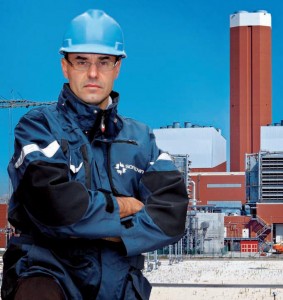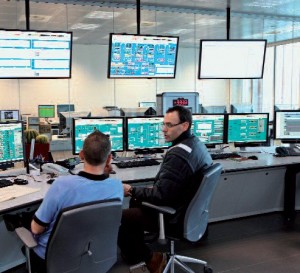13.02.2012 Finmeccanica magazine № 22

Nicola Gregorini, 41, from Lombardy, is married with four children. He holds a degree in mechanical engineering from the Politecnico di Milano. He has spent a “lifetime” on energy. Before joining Sorgenia, he was employed in engineering and technology at Edison and then project management at oil and gas company Pietro Fiorentini. After spending some years in operation and maintenance at Sorgenia, he became head of the Turano Lodigiano - Bertonico plant in Lodi, the latest combined cycle plan, which was a “turnkey” delivery by Ansaldo Energia Italy
Managing an electroc power plant requires passion and commintment to both high tecnology and anvironmental protection. We discuss the job with Nicola Gregorini, manager of the Sorgentia plant in Turano Bertonico — Lodigiano (lodi).
What does it mean to work in the energy sector?
In the current climate, it mainly means having a job! For someone with a technical background, like me, or someone passionate about engineering or electrical engineering, working in a plant also means gaining hands-on experience of something that might otherwise always be purely theoretical. Energy truly affects all of us, from the youngest to the oldest: that’s why we are always very interested in initiatives with schools and universities, ranging from simple open days to scholarships to internships at the plant.
What does the title ‘plant manager’ mean? What tasks and responsibilities does the role involve?
I could give you a long list of tasks and things that have to be done, both every day and as part of planning, but I would rather talk about the responsibility that I think is most important: personnel management, i.e. listening, motivating, delegating and sharing together the challenges of work, the joys and results that derive from it. Managing any corporate organization means making the well-being of he people you work with and for an absolute priority. This means sharing their problems and successes in an active, real way. Of course, targets for output, the maintenance budget and various fixed costs also have to be considered, as well as the availability and reliability of the plant and investments in various improvements and upgrades, but all these valid corporate objectives fit into a more general principle: if people work well together and gain satisfaction and reward from what they do, targets are always met.
What is a “normal” day for a plant manager?
I wake up at 7 and get to the plant at 8. I have a short operations meeting in the control room to see what has to be done, then check plant operation from the control room, do a check of the daily activities on the ground, go back to the office and have meetings. At the end of the day I spend a few hours analyzing things that have recently happened, particularly inefficiencies or significant events, and thinking about measures to be taken at the plant in the broadest sense, relating to the personnel, for example, or to improvements, safety, spare parts, etc.
What sorts of problems occur, and how do you tackle unexpected events?
Unexpected problems come up at the plant on a daily basis, and it is important to be prepared also psychologically; on this, I can say that all personnel at the plant have greatly advanced during this first year in operation, in terms of both their expertise and their ability to fix things at the plant, and also in having a calmer approach as demonstrated by repeated events that are sometimes very difficult to manage. I’m thinking, in particular, of the maintenance personnel, who are specifically required to be available all week, including for shift work.
 Turning to MMI, or Man Machine Interface: let’s talk about the control room and the technology, but also about people and their emotions and fears…
Turning to MMI, or Man Machine Interface: let’s talk about the control room and the technology, but also about people and their emotions and fears…
There are perhaps emotions at the beginning, when you are not completely sure about everything going on behind the screens, the buttons, the systems and the thousands of resets, behind the thousands of operations that you have to perform to start up a power plant. Anyone who tells you that it is simply a question of pushing buttons is talking nonsense. Automation only helps if you already know the plant and how to operate it, even with your eyes closed. For example, all the shift foremen and shift operators have, or are training for, licenses to operate the steam generators. It can sometimes be worrisome, especially if you are doing new things or things that require maneuvers that you may have only performed once, some time ago. The important thing is to conquer your fears and this takes experience, and – alas – every so often, system shutdowns. The plant is a bit like a mountain: you should respect it, not fear it.
You have only 18 employees for a very large and complex plant: what role does automation play with regard to the plant and the flexibility of operations?
Actually the headcount increased to 19 in early October 2011, when someone was recruited for administrative management of purchase orders and procurement contracts. The company also plays a crucial role in carrying out general maintenance, through which we outsource labor. Technology, engineering and plant automation therefore play a critical role: without the right technology, good planning and driven automation it would be impossible to operate a plant with only two people present, and tackle unexpected problems with only a small sacrifice in terms of maintenance. I won’t deny that the first year was really tough and that on all three fronts we can and must, especially now, work to improve a foundation that is already strong.
How do you address the question of plant and personnel safety, apart from by complying with the legislative standards?
This is a fundamental – I would say primary – issue for the company: all the people who work at the plant now have the mindset that they have to analyze and assess the risks associated with any action before they take it, to ensure maximum safety. We do not work at the plant unless it is safe, and anyone failing to keep to this cardinal rule will be let go. Of course training is required to create a safe environment, but the correct approach, expertise and a lot of experience are the most important factors.
This new plant makes Sorgenia one of the biggest companies operating in Lodigiano. How do you manage your relationship with the region?
Apart from a few exceptions and some normal friction, our relationship with the region has always been very good, as well as in the other areas in which Sorgenia operates. The relationship with the authorities is directly managed by senior management, while I manage relations with a wide range of different entities in the region, possibly smaller in scale but no less important. It is always useful to listen to everybody and to try to accommodate their wishes whenever possible, because the people who work here, especially the plant manager, represent the face of Sorgenia in the region.
Sorgenia is creating an environmentally friendly image: what is the reality at Turano?
We are the most efficient power plant in Italy, I believe, and we work hard to improve. This means making the best possible use of the valuable resource of the natural gas that we burn in the gas turbine, and releasing less carbon dioxide into the atmosphere. Last August we completed the installation of a carbon monoxide catalyst on the first boiler, which will reduce emissions of this pollutant by an estimated 70% on an annual basis. Soon, when we shut down for maintenance operations, we will do the same with the second boiler. The machines in operation for over a year have nitrogen dioxide emissions well below the authorized limit of 30 mg/Nm3. The use of cooling systems (air-cooled condensers and air heaters) creates a considerable saving of water resources and enables us to fully recover all process wastewater and rainwater (dirty and clean). By the end of 2011, we plan to have total water consumption equivalent to that of a small business. We do not discharge anything to surface water (i.e. it does not pollute any streams, rivers, or surrounding fields, ed.) or any wastewater and we recycle everything, producing only products for disposal in landfills, such as salts and mud. Although this is expensive, it allows us to eliminate any possible source of environmental pollution. The plant is also extremely quiet, because the equipment is produced according to highly restrictive design criteria, and all sources of noise are confined in acoustic buildings or cabins. Even in the middle of the countryside, where at night absolute silence reigns, the plant cannot be heard. The company has also invested a lot in the ‘look’ of the plant, which I would certainly call beautiful, with appropriate, comfortable working spaces for personnel and open, green, planted areas.
The Sorgenia power plant at Turano Lodigiano is comprised of a combined-cycle plant with a total output of 800 MW. Ansaldo Energia was the plant’s EPC Contractor, i.e. “turnkey” supplier. The core of the plant consists of:
• two AE94.3A4 gas turbines;
• one RT 30C steam turbine;
• three TR Y/X L56 generators;
• two recovery boilers with three pressure levels;
• one 42-cell air-cooled condenser.
The other components are the gas plant, the thermal cycle and auxiliary systems, including an auxiliary boiler and a water demineralization and recovery plant (ZLD — Zero Liquid Discharge), and the electrical section, including an armored substation (GIS) for interface with the Terna substation, the plant automation system (DCS) and the plant’s civil engineering works. The power plant was designed with a strong focus on environmental aspects and a high level of operational flexibility, which are now the key elements for success for energy producers operating in an increasingly competitive electricity market. The combined-cycle solution and the technology provided by Ansaldo Energia enable the plant to produce high yields with a low impact in terms of atmospheric emissions. Although the plant is located in an industrial area at a considerable distance from major population centers, it was designed according to specific architectural requirements in keeping with the environment and countryside, reducing its visual impact and limiting sound emissions. The buildings are insulated with sound-insulating and sound-absorbing panels, and the impressive concrete pathway, which is about 100 meters long and hexagonal in shape, gives the plant a distinct appearance, as does the color used for various parts of the facility: brick red was chosen to reflect the colors of the surrounding environment. In terms of power generation, the plant was designed according to national grid voltage and frequency requirements, pursuant to Terna (national grid regulator) rules. From a functional point of view, the plant was designed to ensure maximum operating flexibility while respecting the legal limits for pollutants in atmospheric emissions. The customer can also operate the plant by varying the load at peak times every day and on weekends.
От Редактора: Удельная численность персонала на станциях РФ составляет 4 чел. на 1 МВт установленной мощности (на 2004 год), что в 1,5 раза больше, чем в 1990 (2,6 на 1 МВт). /Данные ЭНИН им. Кржижановского, июнь 2011 г./. Соответственно, на условной станции РФ мощностью 800 МВт работает 4*800=3200 чел
